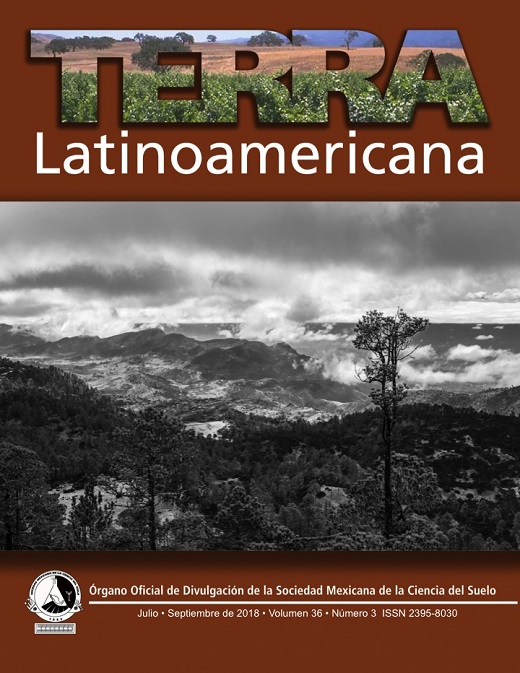Ver ítem
- xmlui.general.dspace_homeCentros Regionales y EEAsCentro Regional Entre RíosEEA ParanáArtículos de divulgaciónxmlui.ArtifactBrowser.ItemViewer.trail
- Inicio
- Centros Regionales y EEAs
- Centro Regional Entre Ríos
- EEA Paraná
- Artículos de divulgación
- Ver ítem
Seasonal variation of soil aggregate stability, porosity and infiltration during a crop sequence under no tillage
Resumen
Soil properties vary over time with soils presenting
different susceptibility to runoff and erosion during the
year. Under no-tillage cropping, soil physical properties
could change mainly due to the climatic factor effect,
crop type and wheel traff ic. The aim of this study was to
analyze the seasonal variation of selected soil physical
properties of an Aquic Argiudoll under no-tillage,
focusing on their relationship with water
[ver mas...]
Soil properties vary over time with soils presenting
different susceptibility to runoff and erosion during the
year. Under no-tillage cropping, soil physical properties
could change mainly due to the climatic factor effect,
crop type and wheel traff ic. The aim of this study was to
analyze the seasonal variation of selected soil physical
properties of an Aquic Argiudoll under no-tillage,
focusing on their relationship with water partitioning
between inf iltration and runoff during a typical crop
sequence of the Pampean region (Argentina). The
study was carried out in an agricultural f ield located
at the Paraná Experimental Station of the Instituto
Nacional de Tecnología Agropecuaria (INTA) in Entre
Ríos province (Argentina). Soil samples were taken
at six different times during the crop rotation cycle.
Soil water content, bulk density, pore size distribution,
structural stability and water inf iltration obtained with
a rainfall simulator were determined on each sampling
date. To relate the behavior of these soil properties
with the previous weather conditions, we considered
different climatic variables. Our results showed that
there was no influence on soil physical properties of
the crop type or the wetting and drying soil cycles.
However, in this high silt content Argiudoll with a
moderate to high contraction and expansion capacity,
it was found that soil macroporosity was higher in drier
soils, reducing the runoff coeff icient. Furthermore, soil
structural stability also affected the inf iltration capacity
of this soil during some periods, resulting in a better
structure during periods of higher temperature. We
conclude that the critical period for this Argiudoll to
generate runoff would be mid-autumn to early spring,
when the soil water content is higher, temperatures
are low, and therefore macroporosity, soil structural
stability and inf iltration rates have worse values. In this
sense, winter cover crops is a management practice that
will favor the soil drying and coverage, reducing runoff
risk during this period.
[Cerrar]
Las propiedades edáficas varían en el tiempo,
presentando los suelos durante el año diferente
susceptibilidad al escurrimiento y la erosión. En
siembra directa, las propiedades físicas edáf icas pueden
variar fundamentalmente debido a efectos climáticos,
del cultivo o por el tránsito de la maquinaria. El
objetivo del presente trabajo fue analizar la variación
estacional de algunas propiedades físicas edáf icas en
un Argiudol ácuico bajo siembra
[ver mas...]
Las propiedades edáficas varían en el tiempo,
presentando los suelos durante el año diferente
susceptibilidad al escurrimiento y la erosión. En
siembra directa, las propiedades físicas edáf icas pueden
variar fundamentalmente debido a efectos climáticos,
del cultivo o por el tránsito de la maquinaria. El
objetivo del presente trabajo fue analizar la variación
estacional de algunas propiedades físicas edáf icas en
un Argiudol ácuico bajo siembra directa, determinando
su relación con la inf iltración y el escurrimiento
durante una secuencia de cultivos característica de la
Región Pampeana (Argentina). El estudio se desarrolló en un lote perteneciente a la Estación Experimental
Agropecuaria Paraná del Instituto Nacional de
Tecnología Agropecuaria (INTA), ubicado en la
provincia de Entre Ríos (Argentina). Se obtuvieron
muestras de suelo en seis fechas diferentes durante la
secuencia de cultivos. Se determinó en cada una de ellas
las siguientes propiedades: contenido de agua, densidad
aparente, distribución de poros, estabilidad estructural
y la inf iltración de agua medida con un simulador de
lluvias. Para relacionar el comportamiento de estas
propiedades con las condiciones climáticas previas,
se consideraron distintos parámetros climáticos.
No hubo influencia de la especie cultivada y de los
ciclos de humedecimiento y secado del suelo sobre
las propiedades físicas evaluadas. Sin embargo, este
Argiudol con un alto contenido de limo y con una
capacidad de contracción-expansión entre moderada
y alta, mostró una mayor macroporosidad con suelo
seco, disminuyendo el coef iciente de escurrimiento.
La capacidad de inf iltración estuvo también afectada
por la estabilidad estructural, siendo esta más favorable
en períodos de mayor temperatura. Se concluye que el
momento crítico de este Argiudol para la producción
de escurrimiento sería desde la mitad de otoño hasta
el comienzo de la primavera, cuando el suelo tiene
mayor humedad y hay bajas temperaturas, con
consecuencias negativas sobre la macroporosidad,
estabilidad estructural e inf iltración. En tal sentido,
la implementación de cultivos de cobertura durante el
invierno, es una práctica de manejo que favorecerá el
desecamiento y la cobertura del suelo, disminuyendo
en dicho período el riesgo de escurrimiento.
[Cerrar]

Autor
Castiglioni, Mario Guillermo;
Sasal, Maria Carolina;
Wilson, Marcelo German;
Oszust, José Daniel;
Fuente
Terra Latinoamericana 36 (3) : 199-209. (2018)
Fecha
2018
Editorial
Sociedad Mexicana de la Ciencia del Suelo
ISSN
0187-5779
2395-8030 (Online)
2395-8030 (Online)
Formato
pdf
Tipo de documento
artículo
Palabras Claves
Derechos de acceso
Abierto
 Excepto donde se diga explicitamente, este item se publica bajo la siguiente descripción: Creative Commons Attribution-NonCommercial-ShareAlike 2.5 Unported (CC BY-NC-SA 2.5)
Excepto donde se diga explicitamente, este item se publica bajo la siguiente descripción: Creative Commons Attribution-NonCommercial-ShareAlike 2.5 Unported (CC BY-NC-SA 2.5)


